Writing blog content that’s not only comprehensive and coherent, but also drives a meaningful amount of traffic to your website doesn’t need to be a difficult endeavor. While it takes time, effort and practice to become a strong writer, developing your ability to write a blog post that captivates the attention of your readers is something you can make quick progress on—with the right guidance.
I’ve been blogging for some of the world’s top startups (like Google, LinkedIn, Zendesk, Adobe and Intuit) for well over eight years. In that process I’ve gone from fumbling around with starting my own blog, to perfecting a step-by-step writing process that now brings my blog over 400,000 monthly readers.
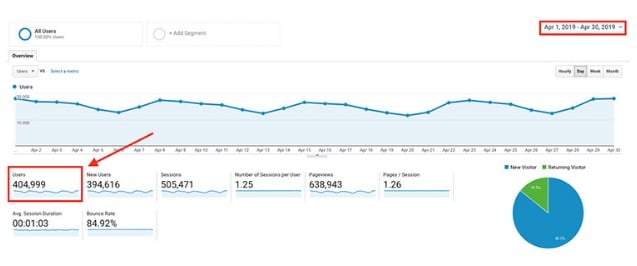
In today’s guide, I’ll walk you through the following:
- How to better understand your readers
- My formula for generating creative blog post ideas that’ll capture the attention of new readers
- Writing headlines that encourage more clicks
- Structuring an article for maximum readability
- Nailing your storytelling
- And more!
Get to know your readers
Before you even begin writing content for your company blog, you’ll need to identify a range of topics that’ll actually capture the attention of the readers you want. Approach content creation like you would start a conversation—begin by finding common ground.
To deliver value to your readers, you need to write about things they want to know about, not just what you want to tell them.
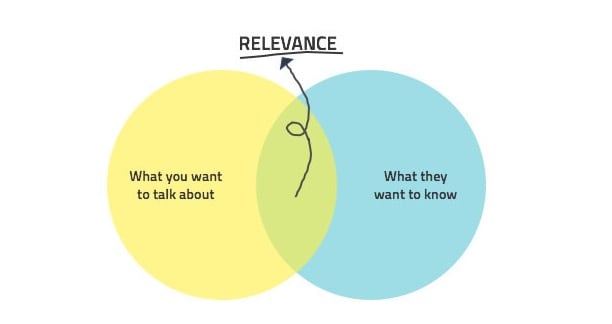
Do you really know what your audience is interested in?
If not, then that’s your most important mission at this stage. Keep in mind that understanding your audience is much different than simply doing keyword research and identifying opportunities that could bring in readers. That’s attempting to solve your traffic problem backward.
The goal is not figuring out what topics are popular in general. You’re trying to figure out what your audience wants to know, as it relates to your own interests.
Here are a few of my favorite ways to start pinpointing meaningful topics I know I’ll need to cover for my readers, by first answering these kinds of questions:
- What are my readers’ most pressing needs in the long-term?
- Which concerns do they have top of mind today?
- What are their skills and ability levels?
- How about a general focus area they’re concerned with?
- What kinds of goals do they have for themselves?
- Any unique struggles of my own that I can share?
If you invest the time into polling your readers and truly understanding where they come from, you’ll learn how to write content that cuts to the core of their needs.
Write a clever headline for your blog post
Strong headlines are marketing tools in and of themselves. They represent your article across social media platforms, in Google search results and within emails.
Before people even start reading the blog post, your title is already shaping their opinion of it.
In fact, six out of 10 people report only reading a blog’s headline before they share the post on social networks like Facebook, Twitter and LinkedIn.
So how do you write a captivating headline that’ll encourage people to read, click and share?
Well, while it’s important to spend some time on the headline, you also can’t afford to allow yourself to get hung up trying to craft the perfect headline—you’ll eat through time and have little to show for it.
Instead, start with a simple working title that you can change later.
For example, when I first started this article you’re reading right now, my working title was very simple: “How to Write a Blog Post.”
As I moved through the process of fully outlining and then writing the article, the headline took more shape as I identified and clarified all of the working components required to produce this guide.
Before publishing, it grew into something that was significantly expanded (and more interesting) for potential readers who stumble upon this guide on social media, in search engines or otherwise.
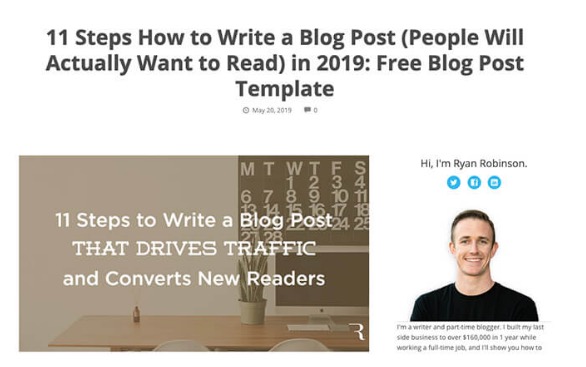
Let’s break down a few elements of what makes this headline captivating:
- It leads with a number, making it (1) stand out visually in organic search results and (2) very quick to communicate to readers that it’s a step-by-step tutorial-style article
- Next, it includes the target keyword phrase that’s at the core of exactly what potential readers are hoping to learn how to do here (which is good for both search engines and matching reader-intent)
- After that, I’ve included a portion of the headline in (parentheses) which also tends to make it pop visually on a search engine results page
- We’ve also got the current year included in the headline, showing that the article is currently up-to-date (it’s also updated each year when the article is updated)
- Finally, I’ve ended the headline with “Free Blog Post Template” which is something no other current guides on this subject are offering people (my competitive advantage with this guide) and another quick indicator of what readers can expect to get with this article
As I’ve said already though, the final version of this headline didn’t come until I’d fully written and edited this post.
While it’s tempting to wait for clarity before taking action, the truth is that clarity comes throughaction.
Just start writing and the headline ideas will flow as you progress. As time goes on as you move into a more comfortable place as a writer, headlines will also become more natural for you to craft.
Also leverage the curiosity gap. Write an irresistible headline that teases what’s in the piece without giving it away completely.
Curiosity is one of the most powerful human emotions, and wielding it effectively is all about balance. The trick is to provide just enough information to drive people to learn more, but not so much that they don’t feel compelled to investigate further.
Lastly, be sure to optimize for search and social. These two channels will be major sources of traffic for your content, so you need to be concerned with how your article headlines will be read and interpreted on these platforms.
- Is your headline exciting to tweet?
- Will it stand out in a noisy Facebook feed?
- Does it include a featured image that people will click on from Pinterest?
Using keywords to increase your chances of showing up in search results is always a good idea (more on that later), but you need to give yourself every opportunity you can to help engineer a headline that can accurately reflect your content and go viral on social.
Hook your readers from the start
You have one sentence (two at most) to entice readers and draw them into your blog post. Just like meeting someone for the first time, first impressions with a blog post are critical and affect whether we choose to get to know someone better—or make our way to exit.
As you’re learning how to write a blog post, here are a few dos and don’ts for crafting an interesting introduction:
Do:
- Use colorful language
- Open with a startling statistic
- Start with a quote
- Use drama or humor
- Leverage eye-catching formatting (like bold and italics)
Don’t:
- Use a cliche that’ll leave readers rolling their eyes
- Bury the lede (failing to tease the most interesting point in your article)
- State the obvious
The easiest strategy for crafting a compelling lede is to answer the who, what, where, when and why as soon as possible.
This may sound counterintuitive when just learning how to write a blog post, but another trick is to start with your conclusion first. In the age of short attention spans, people have grown tired of wasting time on clickbait blog posts that go nowhere.
The quicker you can establish relevance to your reader, give them a strong reason to believe they’ll find what they’re looking for in your blog post, the more likely they’ll be to dig into your piece and share it with others.
Answer questions with your blog posts
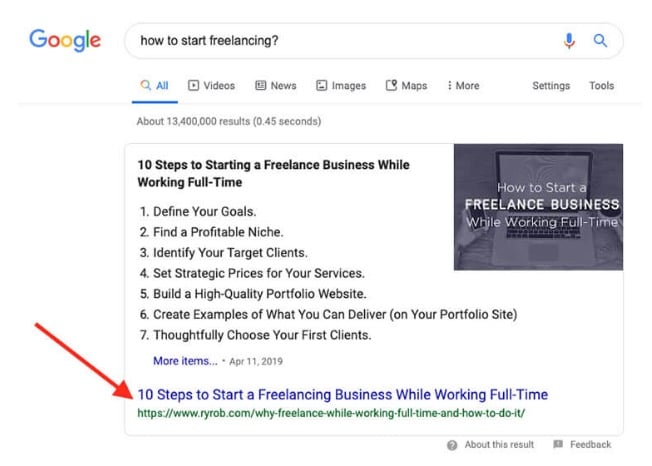
Google has gotten very good at figuring out not just what topics people are searching for, but what their intentis.That’s why being a strong content marketer is no longer just about delivering content that matches the words and phrases people are using; it’s all about delivering satisfying answers to reader questions, challenges and problems.
This has resulted in a growing number of zero click searches—results that highlight featured snippets, paid ads, knowledge panels, maps, and videos that answer search queries without sending users anywhere (like the screenshot above).
In the eyes of search engines, your site has gone from a destination to a source of data.
Search for a restaurant and you’re likely to find a knowledge panel packed with ratings, hours of operation, location and top dishes with the restaurant’s actual URL buried somewhere near the bottom of the featured snippet.
While this is arguably better, easier and faster for searchers to find the answers they’re looking for, it’s bad for content creators (like you) that want to control the experience for their readers.
However, it’s not all bad news.
The advent of featured snippets and knowledge boxes means that there are also a ton of new opportunities to get creative and break into these high-visibility featured snippets. Thus, outranking your competitors and giving yourself the best shot and bringing the most engaged readers to your blog.
Here’s how to optimize your blog content for securing a featured snippet:
- Figure out exactly what people are asking relevant to your industry (observe suggested search results on sites like Google and Quora)
- Make those questions the headers in your blog post (utilizing proper H1s, H2s and H3s)
- Create a structured, hyperlinked menu near the top of your blog post using the same proper text formatting
- Hyperlink each menu item to its corresponding sub-header below (to make the post easily navigable)
- Answer all of the most common questions related to this search term succinctly (using question and answer format)
Aside from the obvious benefits of clearly answering the most pressing reader questions in your blog posts, doing so with smart formatting can reward you immensely.
Related: 11 Unethical Ways to Increase Traffic to Your Website
Tell a captivating story
Humans have been telling stories for thousands of years, and for good reason. Stories stir emotions, forge connections, and are easy to remember.
On top of just the story component, people connect with other people. Sharing your own authentic stories will set you apart from the thousands of generic, content-farm blog posts that go out every day from other businesses—and will help you connect with your audience on a much deeper level.
To this date, my most engaged pieces of content have been the ones that go deep into my own stories, challenges and lessons learned along my journey as a freelancer, entrepreneur and blogger.
Learn how to write content that leverages storytelling and you’ll remain memorable to your readers.
If you’re unsure of where to find inspiration for stories to tell on your blog, start with:
- Your own experiences
- The experiences of your readers
- Things you’ve read
- Something you’ve created on your own
- You can even write a story in collaboration with your readers
Regardless of how you land on the concept, every great story must have these four characteristics:
- It’s simple: An overly complex or convoluted story is difficult to keep track of and remember as a reader, let alone write. Keeping your stories simple will help your readers stay engaged and make it easier for you to convey your message.
- It’s memorable: What good is a story if people can’t remember it later? Great stories are meant to be reflected on, remembered and be retold. Vivid language and exciting situations can help make your story stand out in your reader’s minds.
- There’s a compelling conflict: Conflict is what pushes the story forward. Without conflict, it’s hard to be memorable and even more difficult to stir the emotions of your readers.
- There are incredible characters: You may have all of the right elements but without lovable (or despicable) characters, your story is unlikely to have the impact you want it to. Give your readers someone to cheer for and see themselves in (or jeer at and want to object against).
One of the most common story formats we’re all conditioned to expect from a very young age is the Hero’s Journey. Its most simple format involves a hero who goes on an adventure, and in a decisive crisis wins a victory, then returns home transformed for better or for worse.
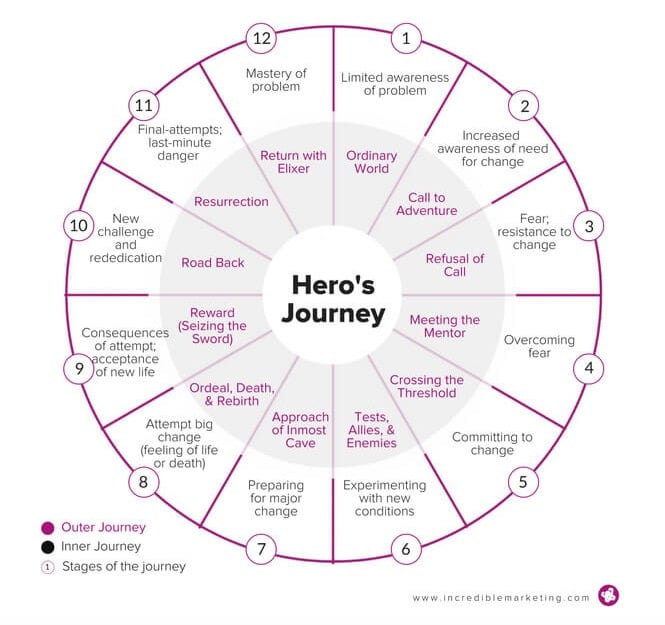
Use the Hero’s Journey as your template to tell stories that’ll keep your readers coming back and wanting more.
Make your content easily scannable
People rarely read word for word on the web. Unless they’re extremely interested in the topic, most people will just quickly scan. And as I mentioned earlier, the majority of us don’t even fully read the content we shareonline; whether through social media platforms, over email or word-of-mouth.
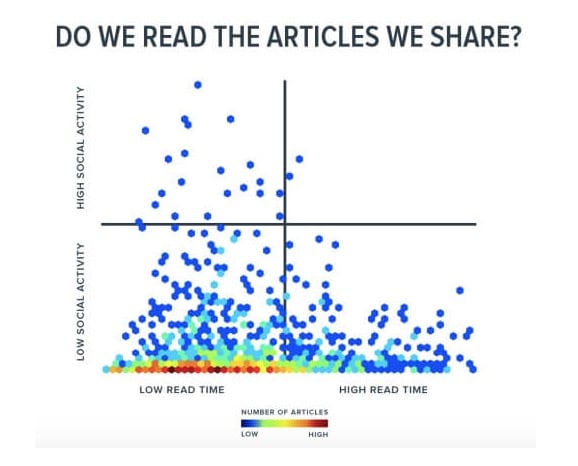
Eye-tracking studies have revealed most people read about 20 percent of the text on a web page. Skim reading is the new normal.
In one usability test by Nielsen research, scannable and objective copywriting resulted in 124 percent better usability.
Sticking with our theme of content that’s formatted for your readers to actually consume, here are a few tips for creating scannable content your audience will enjoy:
- Keep your paragraphs and sentences short (aim for a maximum of three to four vertical lines)
- Use simple words
- Include bulleted lists
- Use sub-headings to break up your posts into sections
- Play around with formatting like bold, italics, different text sizes and format to emphasize
- Add a few block quotes (or tweet quotes)
- Frequently utilize images, charts, and tables
While it may be discouraging to learn that people won’t read every word you write, creating scannable content forces you to focus on only the most critical information your reader needs to know.
Plus, being able to trim the fat will make you a better and more effective writer.
Invest in thoughtful design
Humans are visual creatures. More than 50 percent of our brains are used to process visual information, compared to just 8 percent for our sense of touch and 3 percent for our sense of hearing.
In his book “Blink,” Malcolm Gladwell described the system our brains use to make split-second decisions outside of our conscious awareness, the Adaptive Unconscious. It’s constantly scanning our environment, evaluating stimuli and making judgments based on how things appear.
Because of the importance our brains place on the way things look, improving the visual appeal of your blog can increase perceived credibility, trust, and value.
Conversely, when you write content with unappealing designs, inconsistencies or visual errors, it can quickly chip away the trust and authority you’d otherwise gain with readers.
Here are five proven ways to improve your blog’s visual aesthetics, so that readers will want to stick around:
- Use lots of images: Photos, illustrations, graphs and charts break up the text and reinforce your ideas. When it comes to photos, life-like images work much better than cheesy stock photos. Snag a few pics from sites like Unsplash for a less “staged” look.
- Use proper formatting: In addition to helping with blog SEO best practices, the use of headers and other formatting tags provide crucial visual structure for your content and make it much easier to follow along with (or scan).
- Optimize your layout: When viewing content on the web, people tend to scan in an F-shape pattern. Useful design can help prevent F-shape scanning, but it’s still a good idea to put critical page elements along the top and left side when you write a blog post.
- Increase your font size: Small text is difficult to read, even for your younger readers. Larger font sizes can also increase reading speed and comprehension.
- Use margins and spacing: Margins, the blanks space between content and page edges, can help balance your design and make your content easier to consume. Include plenty of blank space around blocks of texts to make them more readable and less visually stressful for your readers.
Keep in mind that this should all be done on a budget; especially while you’re in the beginning stages of starting your business and learning how to write a blog post (and build your readership).
Be authentic in your writing
In today’s era of sleazy marketing gimmicks, fake news and paid influencers, people are more skeptical than ever. We’re inundated with all kinds of messaging and we’re getting better and better at quickly moving on the moment we smell something fishy.
One recent study found that only 48 percent of people in the U.S. trust brands, down from 58 percent in 2017.
That makes it more important than ever to learn how to write a blog post that forges a genuine connection with your readers, one built on a foundation of trust, rather than gimmicky tactics just to keep them on the page long enough to extract some advertising dollars.
Authenticity can help your blog stand out and will absolutely benefit your business in three major ways:
- It increases engagement: People are always craving real, authentic interactions. Craft your content with honesty and heart—your audience will be sure to reward you more of their time and attention.
- It elevates your brand: Your unique thoughts and perspectives can differentiate you from the competition. Over time, people will develop trust in you, which will increase your influence in their lives.
- It builds emotional connections: Honesty is refreshing. Be transparent, even if it puts you in a bad light, shows your weaknesses or failures and your audience will be drawn to your candor. It’ll increase trust significantly.
Not surprisingly, some brands are really nailing this today.
Here are a few examples:
Patagonia is all about creating great products without causing unnecessary harm to the environment and they consistently put their money where their mouth is. They donate millions to environmental causes, teach their customers how to repair their clothing so they have to buy less, and even discourage people from buying their products if they don’t really need them.
This unwavering commitment to their values has earned them a level of brand loyalty that is unrivaled in their industry.
Buffer, a social media management tool company, is also very well known for their authenticity and transparency. They’ve famously written about their financial challenges and layoffs, published the salaries for all of their employees, and even shared their revenue figures.
This radical approach to transparency has earned them a ton of free press and a large, passionate user base (including yours truly).
So how exactly can you be more authentic during your writing process?
- Talk like a human: Ditch the corporate lingo, buzzwords and start writing the way you talk. Use short sentences and simple words to convey big ideas, but avoid using slang, which can be distracting.
- Identify your values: What do you really stand for? What is your purpose? What is your “why”? By living in harmony with your values and staying authentic to your message, you’ll be able to attract like-minded people and build your tribe.
- Write about issues you actually care about: Don’t try to chase trends or cash-in on fads. While you may see results in the short-term, people will be able to spot your insincerity from a mile away. Instead, write about issues that have the most relevance to you and your audience.
- Take a stand: Maintaining integrity means standing up for what’s right without compromise. You can’t make everyone happy, so come to terms with the fact that some people won’t be fans when you write a blog post they disagree with. In the long run, taking a stand for what you really believe in will earn you the continued respect and loyalty of your audience that does feel similarly as you.
- Be transparent: Most people are quick to advertise their victories and success while keeping their mistakes and failures far away from public view. While it makes for a nice looking Instagram feed, it’s difficult to forge a real connection with someone who seems so perfect. Take the opposite approach and open yourself up to your audience, warts and all. Be quick to admit mistakes and chronicle your failures.
Make your content portable and mobile-friendly
Everybody knows that content has to be viewable across all devices today. But mobile-friendly design alone is not enough anymore. People are constantly on the move, and the way they consume information is changing. That means re-learning how to write a blog post for the ways in which readers want to digest your content.
Your content needs to be portable to fit lifestyles, not just devices.
Someone may start reading your blog post on a laptop at work, then hop on a bus to head home, making it preferable to listen to a podcast or watch a video instead.
To adapt to these new behaviors, it’s crucial to break your pieces of content up into different mediums so that your audience can quickly consume content in a format that makes sense for them at the time, plus allows them to easily pick back up where they left off last time.
To get started, try turning your existing long-form blog posts into:
- Videos
- Podcasts
- GIFs
- Social posts
- Infographics
- Slide decks
Converting your content into different formats can even help people with difficulties (or disabilities) to benefit from your blog in its various formats.
Accessibility is not optional anymore.
Doing what you can to make your work easier for everyone to enjoy is not only the right thing to do, it’s good for business. Sure, you’ll need to have the right WordPress plugins and templates as a basic foundation for a readable blog, but accessibility also extends into having multiple consumption formats.
Show them the numbers
As we’ve established, most consumers are pretty jaded about gimmicky content these days. Who can blame them? Most of us have been duped, conned and defrauded at one point or another online.
To make your content stand out, show data to back up your claims, increase your credibility and illustrate your points wherever possible. This is a core principle of how to write a blog post that’s convincing.
That’s a major reason why I originally decided to share monthly blog income reports with my readers: to show them that I’m not just writing about what to do in order to start a profitable blog, but I’m actually putting my own advice into practice (with transparent results).

Original data and research are huge differentiators that can help your blog rank higher in search results, build backlinks and increase your authority, influence and credibility.
The first step is gathering the actual data itself. Some of the best sources of original data are:
- Experiments: The first and easiest way to start collecting original data is to conduct an experiment (like this one I did). Form a hypothesis, devise an experiment and summarize your findings. Your experiments don’t have to be elaborate, just share what you’re learning and be transparent with the results.
- Observations: If you can find something you can measure or track, you’ve got a data source just waiting to be analyzed. Decide on a length of time you’ll be monitoring the situation and put the numbers in a spreadsheet for easy analysis.
- Surveys and polls: There are a variety of free and inexpensive tools we can use to run surveys and polls of our audience. Even if your audience is on the smaller side, a well thought-out survey can yield some impressive insights.
- Data scraping: One of the most creative ways to get interesting and original data is called scraping. Build an algorithm or outsource the development of a tool to collect information from websites that hasn’t been explored yet.
Another clever way to use data in your blog posts is to put a new spin on existing research done by others. This is a smarter place to start than investing a ton of time (and financial resources) into your own original studies as you’re still learning how to write a blog post that can effectively communicate data.
While the competition for clicks increases each year and organic traffic from Google continues to shrink, there are still a constant flow of new opportunities to expand your reach and build an audience.
Following these steps, you’ll learn to write blog content that’s poised to stand head and shoulders above the rest.
Source: StartupNation


